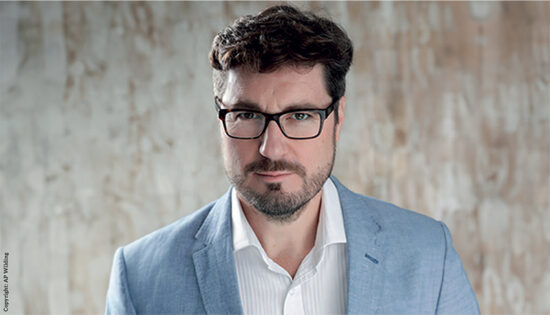What is the brief for your job?
I am currently in charge of intermediary business for UK and continental Europe. Our definition of intermediary means all of the clients that help us bring our value proposition to the end investors. The second bit of my responsibility is for the business unit called Global Financial Institution Group. It tends to cover the activity that is performed by those international big organisations that we have business with. Just to name a few, it could be Citibank, HSBC, UBS or the Axas of this world, which tend to operate with Schroders on a global basis, but like to have a centralised point of contact andcoordination.
How do you split your time geographically?
I’m based in London, and the UK is a large market for us, as you might expect. But Europe is certainly not smaller in terms of presence, when compared to the UK and therefore I do tend to travel across Europe. At the moment, the largest markets for us in Europe are Italy, Switzerland and Germany, from an intermediary standpoint.
How does your product range reflect the differing requirements of investors in countries across the world?
We do have quite a large array of funds and investment solutions. We sell most of our products through Sicavs and globally we have nearly 600 funds that we distribute in 27 countries. So how the product range reflects the market demand is very much from a geographical standpoint.
It is also very much on the basis of our clients’ needs. We decided some time ago to base our international operation around our Luxembourg hub. That has become the natural hub for all of our funds launched with an international remit.
What is the global pattern of the Schroders fund sector sales?
We invested a lot of time in developing local offices where we thought the business opportunities were strong and good enough to justify the presence on the ground. We have always put a lot of emphasis behind speaking the same language in the country where we are hosted as a fund provider, and that has proven to be an extremely valid point in order to penetrate the local culture and understand the distribution mechanism at the local level.
The second thing is a very strong tie with distributors, and learning and understanding what their client base wants. This is not to tell you that we will do anything for anyone, because this is not our nature and this would not be good from a business perspective.
More and more clients want to receive outcome from the product they invest in. Outcome has been a main driver of our business development across different jurisdictions – many years ago we pioneered that. Nowadays it is much more about income, not just offering capital-protected funds or protection for investment. We do have a broad range of income but that has many meanings to different persons and geographical variations. We see an increasing demand for income that for us started in Asia and is spilling over to the rest of Europe, UK and US.
Which are your most popular funds in different countries?
One very big success for us has been Asian Asset Income, which is incredibly popular in that region. In the UK and Europe, the dividend maximiser family has been particularly important for us. We believe the demand for fixed income is now transforming into more sophisticated go-anywhere products in income, such as the strategic bond that a lot of providers have.
We do have our own, and that kind of product is in very high demand and is becoming one of our top sellers. We do also see a certain degree of equity rotation. The theme of providing capital growth in an equity product has always been in our DNA and it will most likely stay there forever.
What is the asset class split that you have in different regions?
From an intermediary standpoint, equities are roughly 45% of the assets that we have under management. Within that, a large part is with Asian countries and the UK. Fixed income is certainly the area where we see demand in continental Europe, although, again, in pockets you have countries that tend to be more equity-driven versus others that are more fixed income driven. Right now, the Nordic countries tend to be more biased towards equities than say Spain or Italy.
What are your key distribution channels?
Our business partners in the UK tend to be the discretionary portfolio managers, IFAs and investment platforms. In Europe, the distribution is mainly bank-based through asset managers that are owned by banks and it is on the pure retail side of the business where they start selling through their own distribution channel.
Is the UK’s RDR regime going to be a factor in continental Europe?
We have all seen what the Netherlands have decided to do. That would be the next UK-like country where you have to offer a rebate-free asset share class to the whole of their distribution, irrespective of whether they are professional buyers or they want to buy it to pass it on to the end client. We have also heard initial discussions being put in place in Sweden and we will wait for others to become more vocal about it. The third one in line could be Switzerland, potentially, but then, again, you know that the regulatory framework in continental Europe is undergoing a revolution, so it is a bit too early to say what the final stage will look like.
Just keeping track of all the regulations is quite a challenge. Certainly we see new distribution models emerging. There is more guided architecture and there is clearly renewed interest towards sub-advisory. It’s always been there but now a lot of the clients are looking at the possibility to achieve more vertical integration, so they are looking at the possibility to outsource the management of certain mandates. It is clear that ETFs could become an important competitive element in the landscape.
One thing we believe is also important is the concentration of flows. You have seen in the market in the past three years quite large flows being allocated to very few fund managers. That is not only a choice based on the performance or the market demand, but it’s also a fact that the guided architecture is becoming more prevalent in the business.
Now this regulatory pressure and the fact you have to hold the responsibility for the range that you offer and manage is suggesting to a lot of players to concentrate on the most valid one and, by consequence, reduce the range they offer.
What product initiatives and marketing plans can you tell me about this year?
In Europe, our largest single initiative is the Global Multi-Asset Income product which launched more than one year ago – but we keep on investing behind this.
This is our flagship fund in terms of multi-asset offering. It’s a solution-based product which would offer clients a 5% return each year, paid out either on a quarterly basis or on a six-monthly basis.
Are you planning to enter any new geographical places or particular market areas?
Are there many other countries that we want to enter? Certainly we’re always looking at the opportunity to expand. A good example is that Schroders was not present in India until last year, when we acquired a 25% stake in Axis AMC, which is a part of the asset management company of a bank there.
We thought it was appropriate for us to look at that opportunity as India was a market that was on our list, but we never tried to go there beforehand. Therefore, we wanted to give it a go, but only when we thought we were not just ready but also when we found the right opportunity.
We are still working around the right positioning of our product and Axis AMC’s products, because they do have their own as well. So it is a work-in-progress.
Let’s not forget that we have a lot of distributors in place which tend to have a broader retail on-the-ground presence. They distribute our funds through their own funds in their own branches in their own banks.
“We are present through a number of international counterparts in Eastern Europe but we do not have an office there. We do not have an office in Russia, but our funds are distributed there.
So that is a big advantage of working with broad and large international organisations.








